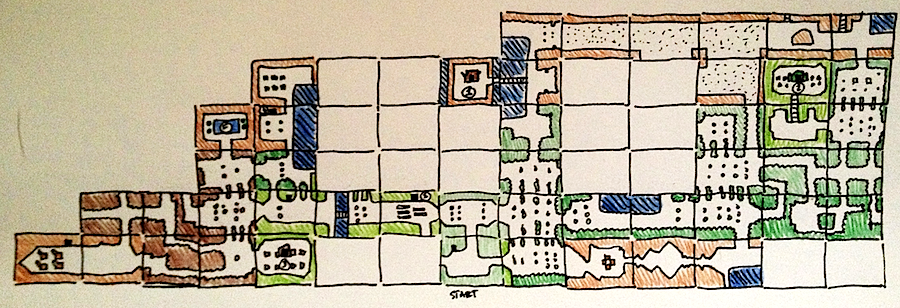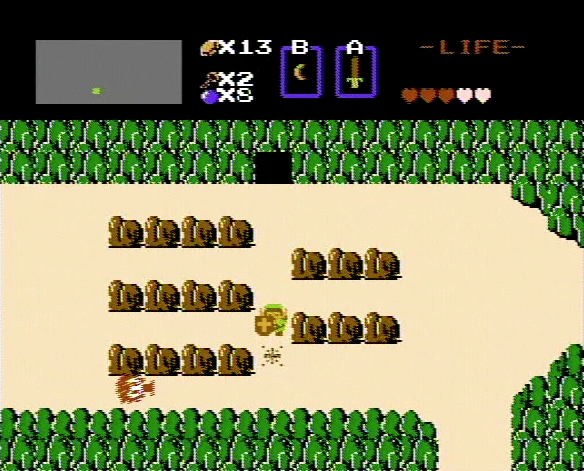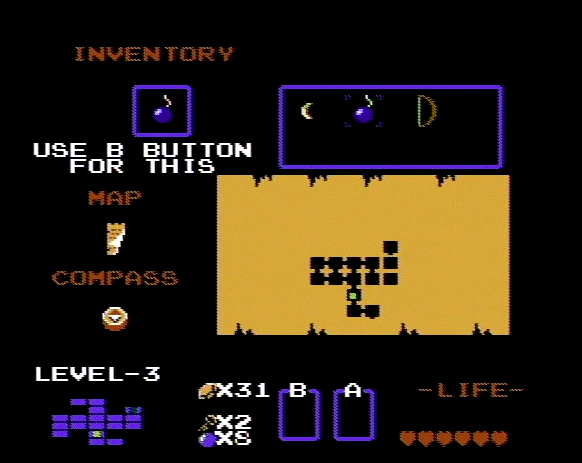The Legend of Zelda Cold Run: Poetics of Mapping
Wherein I discuss de Certeau and the poetics of handmade maps
Allow me to digress.
Capturing video of each Zelda playthrough serves the practical purpose of letting me to focus on the game at hand without needing to pause to write or, worse, recall my explorations from memory. But it has the added benefit of letting me review and map my progress.

Mapping was a big part of games before the Internet arrived. Players could not rely on the game to track their progress, nor could they consult a bevy of FAQs and guides. Technological limitations played a part, but that’s not the only answer–even Zelda includes a simple sprite to track your current position on the overworld and a handy ‘automatic’ map for each dungeon.
But note the way that each is presented. For the former, you merely know your general overworld position, represented by a handful of green pixels on an undifferentiated grey plane. It marks the boundary and scale of the world, but not its features. It’s up to the player to associate spatial locations with specific landmarks.

The dungeon map, accessed in the sub-screen, fills in as Link moves room to room, but it requires halting his progress to consult. The space normally occupied by the grey overworld map again merely indicates your current position in a darkened space. Two items assist your exploration: the compass reveals the Triforce location, while the map reveals the entire dungeon layout. However, this does not obviate the need for the subscreen map; the map item ‘illuminates’ the dungeon’s floor plan, but it does not record the rooms you have or have not visited. Nor does it reveal any hidden rooms or the means to access them. The maps work in concert: one map is locative, the other exploratory (perhaps discursive).

Zelda’s open structure is conducive to mapping. As you inevitably wander, you will encounter items that are inaccessible without the proper gear (e.g. a heart container stranded on a segmented platform in a lake), pathways you cannot reach, or shops with items you currently cannot afford. These may be noted for future visits. The overworld’s gridded structure, reflective of its computational substrate, is easy to plot. And the structure reveals as much in its gaps as it does in its known spaces. Look at the current state of my map in progress; I not only have a record of where I’ve been, but also the coordinates of future explorations. The blanks can be filled.
Have we lost something in the modern designers’ choice to map our spaces in advance? Perhaps our virtual spaces are now too large or complex to map by hand. I’ve had frustration being lost in ‘open worlds’ and often welcome the sophisticated compass/GPS hybrids found in games like Saint’s Row: The Third. But I’ve also found frustration in spaces that were overdetermined, where maps guide my progress step by step, precluding any chance of being lost.
There is also a vernacular charm we lose in the absence of player-made maps. Maps are a personal language. Idiosyncratic. Idiomatic. They express the particularities of a player’s experience in an unknown space. We don’t commonly think of interactivity (a dangerous buzzword) in such a manner, but the texts we generate outside the game are just as interactive as those we generate within. The wonderful Mapstalgia tumblr blog makes this point clear.
In The Practice of Everyday Life, French sociologist Michel de Certeau writes about the ‘enunciatory operation’ of walking in the city, especially those unexpected paths that are never ‘scripted’ in advance by bureaucracies, city planners, and the like. I love this bit:
The long poem of walking manipulates spatial organizations, no matter how panoptic they may be: it is neither foreign to them (it can take place only within them) nor in conformity with them (it does not receive its identity from them). It creates shadows and ambiguities within them. It inserts its multitudinous references and citations into them (social models, cultural mores, personal factors).
Certeau consistently highlights the processes of daily life that push against the strictures of power. Citizens have little control over a city’s architectural plan, but they do control their circuits through its scaffolding. In the same way, we cannot rearrange the tightly structured grid of Hyrule, but we can determine Link’s path. And each player’s path will be unique.
In the instruction manual to Ghost Lion, a little known Final Fantasy / Dragon Warrior clone for the NES, there’s a section at the end called ‘Map Making Tips.’ It reads, ‘Map Making is essential to make sure you go everywhere and do everything in the game, as well as helping you from getting lost.’ But the last tip is the most poignant: ‘Draw what you see. The maps only have to make sense to you; they don’t need to be works of art!’
Not art, just poetry.